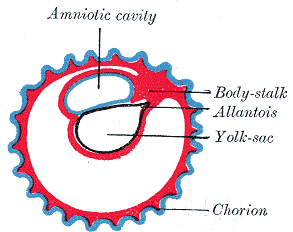Chorion
Chorion is an essential part of the fetal membrane that plays a critical role in the development of mammals, including humans. It is one of the outermost layers that surround the embryo in early development and contributes significantly to the formation of the placenta, which is vital for providing oxygen and nutrients to the growing fetus and removing waste products.
Structure and Function[edit | edit source]
The chorion consists of two main layers: the trophoblast, which is the outer layer that comes into direct contact with the uterus lining, and the mesoderm, an inner layer that contains blood vessels. These layers work together to form the chorionic villi, which are finger-like projections that extend into the uterine wall and help form the placenta. The chorion facilitates the exchange of gases, nutrients, and wastes between the mother and the fetus through the placenta.
In addition to its role in nutrient exchange, the chorion also produces important hormones such as human chorionic gonadotropin (hCG), which is crucial for maintaining the corpus luteum during the early stages of pregnancy. The presence of hCG is used in pregnancy tests, as it is one of the first hormones to be produced by the developing embryo.
Development[edit | edit source]
The chorion begins to form shortly after fertilization, when the embryo starts to implant in the uterine wall. As the embryo develops, the chorion expands and becomes more intricately connected with the maternal blood supply. The development of the chorionic villi is a key step in the formation of a functional placenta, which will support the fetus throughout the pregnancy.
Clinical Significance[edit | edit source]
Abnormalities in the development of the chorion can lead to pregnancy complications. For example, an excessively invasive chorion can result in conditions such as placenta accreta, where the placenta becomes too deeply attached to the uterine wall, potentially causing severe bleeding during delivery. Conversely, insufficient development of the chorionic villi can lead to placental insufficiency, a condition where the placenta cannot adequately support the fetus, leading to growth restrictions or other complications.
See Also[edit | edit source]
Search WikiMD
Ad.Tired of being Overweight? Try W8MD's physician weight loss program.
Semaglutide (Ozempic / Wegovy and Tirzepatide (Mounjaro / Zepbound) available.
Advertise on WikiMD
|
WikiMD's Wellness Encyclopedia |
| Let Food Be Thy Medicine Medicine Thy Food - Hippocrates |
Translate this page: - East Asian
中文,
日本,
한국어,
South Asian
हिन्दी,
தமிழ்,
తెలుగు,
Urdu,
ಕನ್ನಡ,
Southeast Asian
Indonesian,
Vietnamese,
Thai,
မြန်မာဘာသာ,
বাংলা
European
español,
Deutsch,
français,
Greek,
português do Brasil,
polski,
română,
русский,
Nederlands,
norsk,
svenska,
suomi,
Italian
Middle Eastern & African
عربى,
Turkish,
Persian,
Hebrew,
Afrikaans,
isiZulu,
Kiswahili,
Other
Bulgarian,
Hungarian,
Czech,
Swedish,
മലയാളം,
मराठी,
ਪੰਜਾਬੀ,
ગુજરાતી,
Portuguese,
Ukrainian
Medical Disclaimer: WikiMD is not a substitute for professional medical advice. The information on WikiMD is provided as an information resource only, may be incorrect, outdated or misleading, and is not to be used or relied on for any diagnostic or treatment purposes. Please consult your health care provider before making any healthcare decisions or for guidance about a specific medical condition. WikiMD expressly disclaims responsibility, and shall have no liability, for any damages, loss, injury, or liability whatsoever suffered as a result of your reliance on the information contained in this site. By visiting this site you agree to the foregoing terms and conditions, which may from time to time be changed or supplemented by WikiMD. If you do not agree to the foregoing terms and conditions, you should not enter or use this site. See full disclaimer.
Credits:Most images are courtesy of Wikimedia commons, and templates, categories Wikipedia, licensed under CC BY SA or similar.
Contributors: Prab R. Tumpati, MD





